

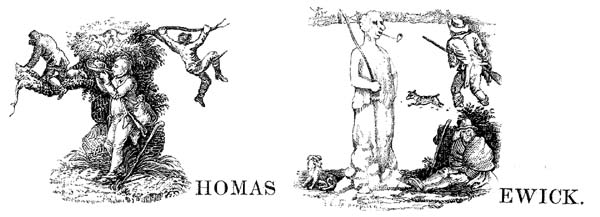
Thomas Bewick (1753-1828) popularized wood engraving as an illustration technique, in which a woodblock was carved with a burin to make a raised design that was then inked and printed. But he also created a new method termed "white-line engraving," in which the design was white, with the background being inked and printed. It is like the difference between drawing with a pen upon paper and drawing with white chalk on a blackboard.
-Bewick's engraved initials taken from William Andrew Chatto's A Treatise on Wood Engraving, (1839). Engraved by John Jackson.
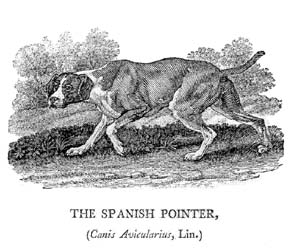 A General History of Quadrupeds. Newcastle upon Tyne, [1790] 1800.
Fourth edition. Engraved and illustrated by Thomas Bewick.
A General History of Quadrupeds. Newcastle upon Tyne, [1790] 1800.
Fourth edition. Engraved and illustrated by Thomas Bewick.
Following in the 18th-century tradition of natural history education, Bewick wanted to produce a work for the "pleasure and amusement of youth." He drew from memory animals he knew, but copied from other naturalists those he did not (such as the elephant and zebra). It was in this work, however, that he discovered his genius for invention in tail-pieces and vignettes, where his humor and satire could be given full vent. For the eight editions of the Quadrupeds published during his lifetime, Bewick added and altered figures and vignettes. Thus, the first edition has 200 figures and 103 tail-pieces, the fourth has 225 figures and 100 tail-pieces, and the seventh 226 figures and 111 tail-pieces.

History of British Birds. Newcastle upon Tyne, 1797-1804. First edition. Engraved
and illustrated by Thomas Bewick.
For this illustration of birds, Bewick was concerned to have the best examples to draw from. He writes, "At the beginning of this undertaking I made up my mind to copy nothing from the works of others, but to stick to nature as closely as I could . . . I was on this account driven to wait for birds newly shot, or brought to me alive, and in the intervals employed my time in designing and engraving tail-pieces or vignettes." The mastery and faithfulness of these depictions rank among the greatest of bird illustrations.
The Fables of Aesop, and Others. Newcastle upon Tyne, [1818] 1823. Second edition. Engraved and illustrated by Thomas Bewick.
Bewick drew the designs during a long convalescence in 1812. He was assisted in the engraving by his son, R.E. Bewick; William Harvey; and William Temple.

A Natural History of British Quadrupeds. Alnwick, W. Davison, [1815?]. Engraved and illustrated by Thomas Bewick.
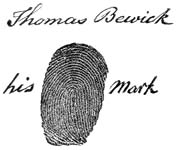
-Thomas Bewick's facsimile signature and thumbprint are from the "receipt" leaf of The Fables.
Oliver Goldsmith and Thomas Parnell. Poems by Goldsmith and Parnell. London:
Printed by W. Bulmer and Co., 1795. First edition. "The Sad Historian" engraved
and designed by John Bewick.
John Bewick (1760-1795) was brother and apprentice to Thomas Bewick. He was more of an interpretive illustrator than his famous older brother, who designed from real life. He helped to design the fourteen blocks for Goldsmith and Parnell, although Thomas Bewick did most of the engraving. Bulmer advertised this volume as being "particularly meant to combine the various beauties of Printing, Type-Founding, Engraving, and Paper-making; as well as with a view to ascertain the near approach to perfection which these arts have attained in this country, as to invite a fair competition with the best typographical productions of other nations."
William Blake. The Wood Engravings of William Blake: Seventeen Subjects Commissioned by Dr. Robert Thornton for his Virgil of 1821 Newly Printed from the Original Blocks Now in the British Museum. London: The Trustees of the British Museum, 1977. Engraved and designed by William Blake.

William Blake (1757-1827), the great English poet
and artist, was commissioned to create a set of wood engravings for Dr. Robert Thornton's The
Pastorals of Virgil Illustrated by 230 Engravings, a schoolbook published in 1821. He
designed and engraved a frontispiece and 20 small illustrations. These are the only wood
engravings Blake is known to have done.
Tobias Smolett. The Adventures of Peregrine Pickle. New York: R. M'Kermut, and B.D. Arden, 1813. Engraved by Alexander Anderson.
Peregrine Pickle was first published in London in 1751, and the style of Anderson's illustrations, particularly with the architectural effects, seeks to reflect that period.
Robert Burns. Tam O'Shanter and Souter Johnny. London: Marsh and Miller, 1830. First edition. Engraved by George Wilmont Bonner and illustrated by Thomas Landseer.
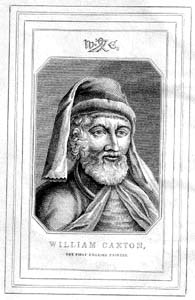
John Johnson. Typographia, or the Printer's
Instructor. London: Longman, 1824. First edition. Engraved by William Harvey, George
Wilmont Bonner, and John Thompson.
John Johnson (1777-1848) published his Typographia: or, the Printer's Instructor in 1824. He had been associated with the Lee Priory Press, one of the earliest private presses in England. He became a master printer in London and was most well known for his facility with printer's ornaments. The first volume of the Typographia is a history of printing, which is derivative and has been superseded. The second volume is a detailed account of contemporary printing practices and contains much valuable information on the technical development of the draft, although Johnson completely disregards the new mechanized printing presses.


The Book of Common Prayer. London: William Pickering, 1844. Engraved and possibly
designed by Mary Byfield.
William Pickering (1796-1854) was a commercial publisher, who announced his intent to produce fine books by adapting the famous anchor and dolphin device of Aldus Manutius, one of the greatest early printers. He claimed himself to be "aldi anglus disciplinus," or the English disciple of Aldus, and set out to raise the standards of typography in England. His taste and care were evident in even his most commercial ventures, such as the popular "Diamond Classics." It was in his special editions, however, that his genius for book design and craftsmanship came to the fore. In collaboration with Charles Whittingham, he produced in the 1840s nine superb folio editions of the Book of Common Prayer, set in Caslon old-style founts, printed on hand-made paper, and decorated with the splendid wood engravings of Mary Byfield. The title page of this volume is justly one of his most famous.

Charles Dickens. Master Humphrey's Clock. London: Chapman and Hall, 1840-1841. First book edition. Engraved by Ebenezer Landells and illustrated by Hablot Knight (Phiz) Browne.
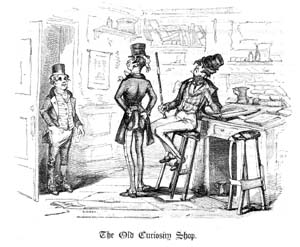
Charles Dickens. Master Humphrey's Clock. London: Chapman and Hall, 1840-1841. First book edition. Engraved by G. Gray and illustrated by Hablot Knight (Phiz) Browne.
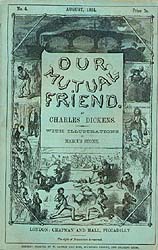
Charles Dickens. Our Mutual Friend. London: Chapman and Hall, 1864-1865. First edition. Illustrated by Marcus Stone.
Most of Dickens's novels were released first in a serial format usually of 20 monthly part issues. This serial issue of Our Mutual Friend (issued from May 1864 to November 1865) is an example of how Dickens's novels initially would have appeared to the public. Cover illustrations for serial and/or paperback editions, as the one featured here, were often executed through wood engraving. Dickens took an active role in the illustration of his books. Page proofs for Master Humphrey's Clock, for example, have survived with Dickens's directions for the placement of designs.
-Parke Godwin. Vala, A Mythological Tale. New York: George P. Putnam, 1851. First edition. Engraved by J.W. Orr and illustrated by Thomas Prichard Rossiter.
Originally written for the New York Evening Post, Vala was considerably modified and enlarged for the book publication. It deals with the principal events in the career of soprano Jenny Lind. Lind, known as "the Swedish nightingale," contracted with P.T. Barnum, the great circus impresario, for an American tour in 1850. Her concert tour was the most successful in American history, and through Barnum's promotional efforts she became associated with such products as pianos, sewing machines, and cigars. Because of the sweetness of her voice and her gifts to charity, she became a national symbol for virtue and purity.
OTHER EARLY WORKS FEATURED IN ON-SITE EXHIBIT
William Andrew Chatto. A Treatise on Wood Engraving, Historical and Practical. London: Charles Knight, 1839. First edition. Engraved by John Jackson.
Chatto's Treatise is an early standard work on wood engraving, which was experiencing significant popularity during this period. Its engraver began as an apprentice to Thomas Bewick and is rumored to have been the actual author of the Treatise.
George Marshall. Epistles in Verse between Cynthio and Leonora. Newcastle: Printed for the author, by Preston & Heaton, 1812. First edition. Includes engravings by Thomas Bewick, Robert Branston, Charles Nesbit, and Luke Clennell.
A Natural History of British Birds and A Natural History of Foreign Birds. Alnwick, W. Davison, 1815? Engraved by Thomas Bewick.
James Tomson. The Seasons. London, 1805. First edition. Engraved by Thomas Bewick and illustrated by John Thurston.
History of Wood Engraving Exhibit || Introduction || Early Period (1790-1860)
Late Period (1860-1900) || Cover Design || Periodicals
Rare Book & Texana Collections || UNT Libraries || UNT
Home>